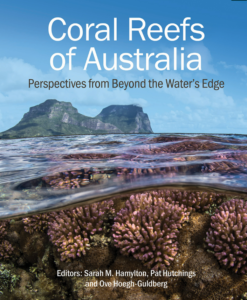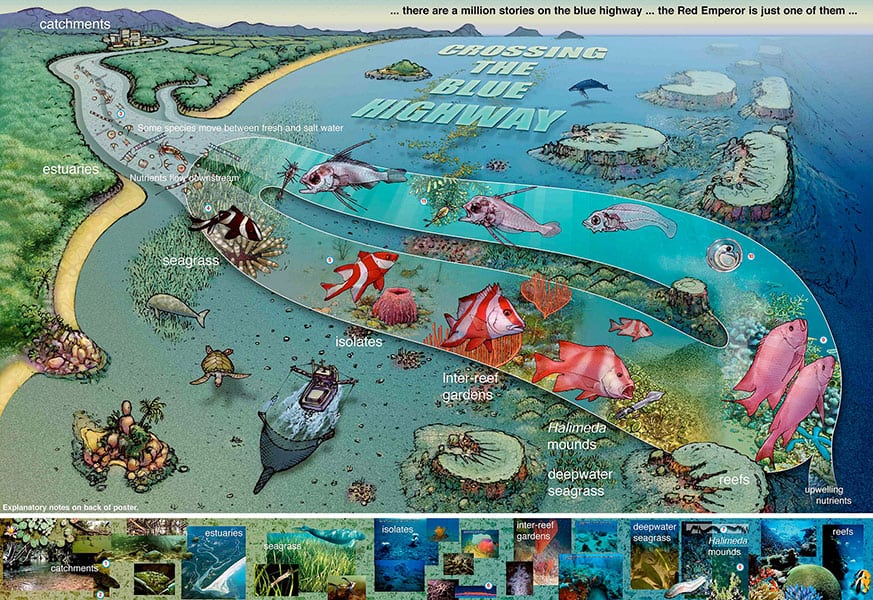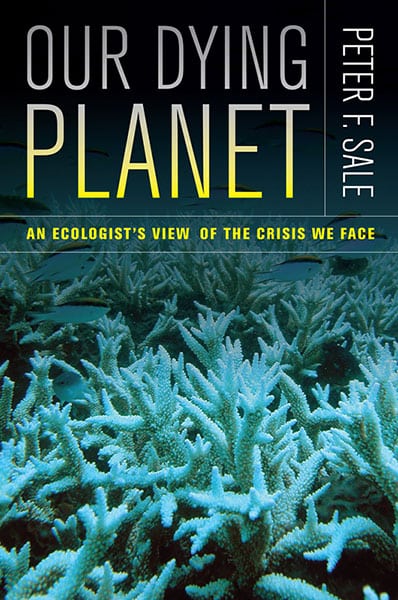ACRS Publications

The remarkable contributions of ten outstanding women to Australian coral reef science
Pat Hutchings, Barbara E. Brown, Maria Byrne, Sarah Hamylton and Tom Spencer
This article summarises the careers of ten women who have made an amazing contribution to our knowledge of Australian coral reefs and their management, and how this contribution has been used by the Great Barrier Reef Committee (subsequently the Australian Coral Reef Society) to conserve and manage our reefs—an ongoing process in the face of climate change.

Coral Reefs of Australia: Perspectives from Beyond the Water’s Edge
Edited by: Sarah Hamylton, Pat Hutchings, Ove Hoegh-Guldberg
Australia’s coral reefs stretch far and wide, covering 50 000 square kilometres from the Indian Ocean in the West to the Pacific Ocean in the East. They have been viewed as a bedrock of coastal livelihoods, as uncharted and perilous nautical hazards, as valuable natural resources, and as unique, natural wonders with secrets waiting to be unlocked. Australia’s coral reefs have sustained a global interest as places to visit, and as objects of study, science, protection and conservation.
Coral Reefs of Australia examines our evolving relationship with coral reefs, and explores their mystery and the fast pace at which they are now changing. Corals are feeling the dramatic impacts of global climate change, having undergone several devastating mass coral bleaching events, dramatic species range shifts and gradual ocean acidification.
This comprehensive and engaging book brings together the diverse views of Indigenous Australians, coral reef scientists, managers and politicians to reveal how we interact with coral reefs, focussing on Indigenous culture, coastal livelihoods, exploration, discovery, scientific research and climate change. It will inform and inspire readers to learn more about these intriguing natural phenomena and how we can protect coral reefs for the future.
Cultural sensitivity
Readers are warned that there may be words, descriptions and terms used in this book that are culturally sensitive, and which might not normally be used in certain public or community contexts. While this information may not reflect current understanding, it is provided by the author in a historical context.
This publication may also contain quotations, terms and annotations that reflect the historical attitude of the original author or that of the period in which the item was written, and may be considered inappropriate today.
Aboriginal and Torres Strait Islander peoples are advised that this publication may contain the names and images of people who have passed away.

The Great Barrier Reef: Biology, Environment and Management
Winner of a 2009 Whitley Certificate of Commendation
The Great Barrier Reef Marine Park is 344 400 square kilometres in size and is home to one of the most diverse ecosystems in the world. This comprehensive guide describes the organisms and ecosystems of the Great Barrier Reef, as well as the biological, chemical and physical processes that influence them. Contemporary pressing issues such as climate change, coral bleaching, coral disease and the challenges of coral reef fisheries are also discussed.
In addition, the book includes a field guide that will help people to identify the common animals and plants on the reef, then to delve into the book to learn more about the roles the biota play.
Beautifully illustrated and with contributions from 33 international experts, The Great Barrier Reef is a must-read for the interested reef tourist, student, researcher and environmental manager. While it has an Australian focus, it can equally be used as a baseline text for most Indo-Pacific coral reefs.
The Great Barrier Reef: Biology, Environment and Management
Winner of a 2009 Whitley Certificate of Commendation
The Great Barrier Reef Marine Park is 344 400 square kilometres in size and is home to one of the most diverse ecosystems in the world. This comprehensive guide describes the organisms and ecosystems of the Great Barrier Reef, as well as the biological, chemical and physical processes that influence them. Contemporary pressing issues such as climate change, coral bleaching, coral disease and the challenges of coral reef fisheries are also discussed.
In addition, the book includes a field guide that will help people to identify the common animals and plants on the reef, then to delve into the book to learn more about the roles the biota play.
Beautifully illustrated and with contributions from 33 international experts, The Great Barrier Reef is a must-read for the interested reef tourist, student, researcher and environmental manager. While it has an Australian focus, it can equally be used as a baseline text for most Indo-Pacific coral reefs.

Blue Highway
The “Blue Highway” graphic is available free of charge to non-profit organisations and by arrangement to media or “for-profit” groups (click here for a low resolution image). Apply to the ACRS President for permission and fee structure. A high resolution version (16 MB TIF) will be supplied.
Publications supported by ACRS

Indo Pacific Coral Finder
Get your copy of the ACRS supported Indo Pacific Coral Finder – the world’s first underwater guide to coral identification and intended for use by divers, students, scientists and resource managers.
Other relevant publications

Coral Reefs and Climate Change
CoralWatch has published “Coral Reefs and Climate Change: The guide for education and awareness”. This book explains the effects of climate change by using coral reefs as an example. Its aim is to inform, educate and enable people to begin to question the future that we are creating right now. It combines some of the latest scientific research with informative imagery to cover topics such as oceanography, coral reef biology, the issues of climate change and suggestions for ways forward. The book is not aimed at scientists but at educators, students, reef enthusiasts, professionals and interested people.

Our Dying Planet: An Ecologist’s View of the Crisis We Face
Author: Peter F. Sale
Coral reefs are on track to become the first ecosystem actually eliminated from the planet. So says leading ecologist Peter F. Sale in this crash course on the state of the planet today. Sale draws from his own extensive work on coral reefs, and from recent research by other ecologists, to explore the many ways we are changing the earth and to explain why it matters. Weaving his own firsthand field experiences around the world into the narrative, Sale brings ecology alive while giving a solid understanding of the science at work behind today’s pressing environmental issues. He delves into topics including overfishing, deforestation, biodiversity loss, use of fossil fuels, population growth, and climate change while discussing the real consequences of our growing ecological footprint. Most importantly, this passionately written book emphasizes that a gloom and doom scenario is not inevitable, and as Sale explores alternative paths, he considers the ways in which science can help us realize a better future.

Aquaculture: Farming Aquatic Animals and Plants
Authors: John S. Lucas and Paul C. Southgate
The output from world aquaculture, a multi-billion dollar global industry, continues to rise at a very rapid rate and it is now acknowledged that it will take over from fisheries to become the main source of animal and plant products from aquatic environments in the future. Since the first edition of this excellent and successful book was published, the aquaculture industry has continued to expand at a massive rate globally and has seen huge advances across its many and diverse facets.
This new edition of Aquaculture: Farming Aquatic Animals and Plants covers all major aspects of the culture of fish, shellfish and algae in freshwater and marine environments. Subject areas covered include principles, water quality, environmental impacts of aquaculture, desert aquaculture, reproduction, life cycles and growth, genetics and stock improvement, nutrition and feed production, diseases, vaccination, post-harvest technology, economics and marketing, and future developments of aquaculture. Separate chapters also cover the culture of algae, carps, salmonids, tilapias, channel catfish, marine and brackish fishes, soft-shelled turtles, marine shrimp, mitten crabs and other decapod crustaceans, bivalves, gastropods, and ornamentals. There is greater coverage of aquaculture in China in this new edition, reflecting China’s importance in the world scene.
Quick Links
Twitter Feed
Get In Touch
Australian Coral Reef Society
c/- School of Biological Sciences
The University of Queensland
St Lucia QLD 4072
